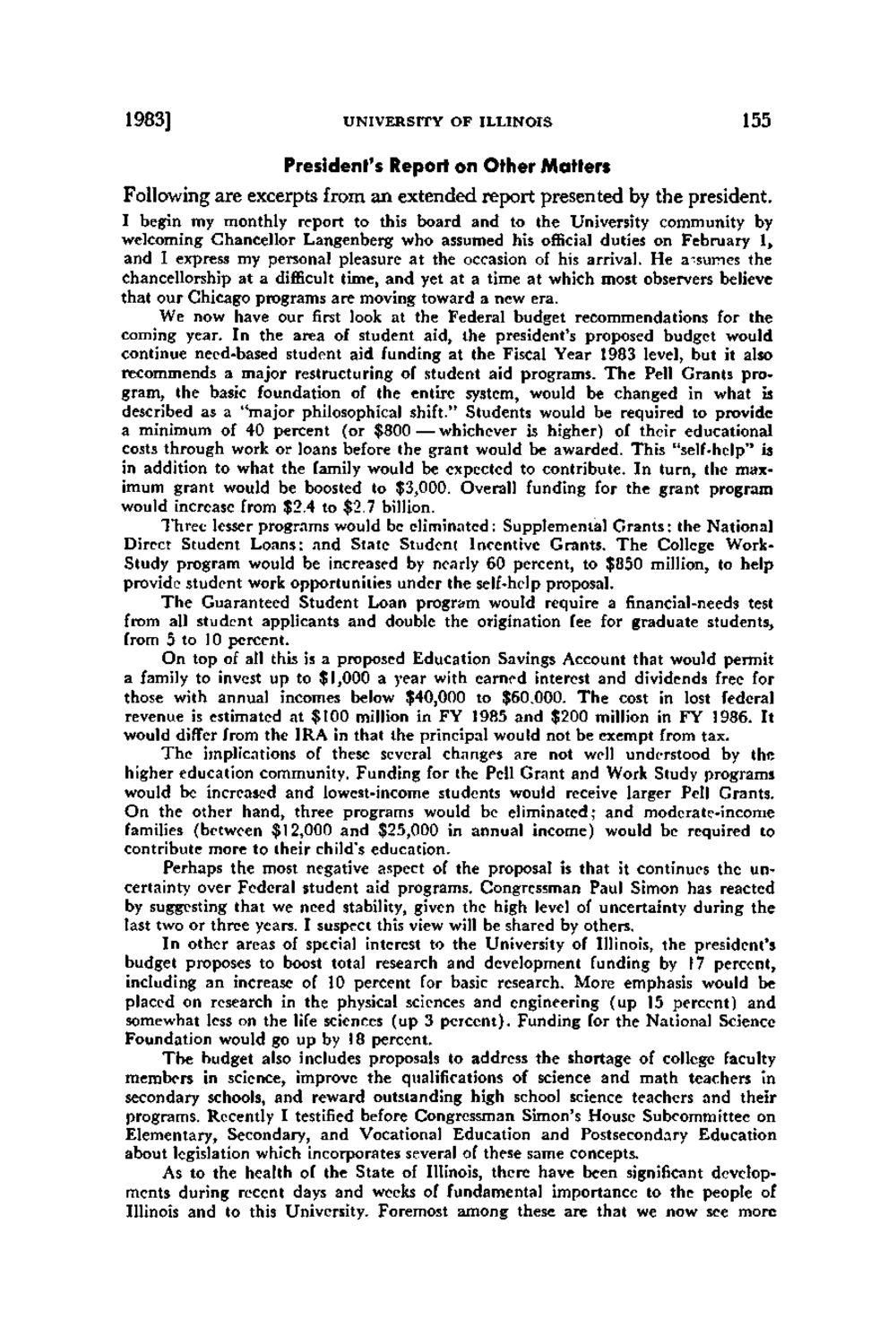| |
| |
Caption: Board of Trustees Minutes - 1984
This is a reduced-resolution page image for fast online browsing.

EXTRACTED TEXT FROM PAGE:
1983] UNIVERSITY OF ILLINOIS 155 President's Report on Other Matters Following are excerpts from an extended report presented by the president. I begin my monthly report to this board and to the University community by welcoming Chancellor Langenberg who assumed his official duties on February 1, and I express my personal pleasure at the occasion of his arrival. He a-sumes the chancellorship at a difficult time, and yet at a time at which most observers believe that our Chicago programs are moving toward a new era. We now have our first look at the Federal budget recommendations for the coming year. In the area of student aid, the president's proposed budget would continue need-based student aid funding at the Fiscal Year 1983 level, but it also recommends a major restructuring of student aid programs. T h e Pell Grants program, the basic foundation of the entire system, would be changed in what is described as a "major philosophical shift." Students would be required to provide a minimum of 40 percent (or $800 — whichever is higher) of their educational costs through work or loans before the grant would be awarded. This "self-help" is in addition to what the family would be expected to contribute. In turn, the maximum grant would be boosted to $3,000. Overall funding for the grant program would increase from $2.4 to $2.7 billion. Three lesser programs would be eliminated: Supplemental Grants: the National Direct Student Loans: and State Student Incentive Grants. The College WorkStudy program would be increased by nearly 60 percent, to $850 million, to help provide student work opportunities under the self-help proposal. T h e Guaranteed Student Loan program would require a financial-needs test from all student applicants and double the origination fee for graduate students, from 5 to 10 percent. On top of all this is a proposed Education Savings Account that would permit a family to invest up to $1,000 a year with earned interest and dividends free for those with annual incomes below $40,000 to $60,000. The cost in lost federal revenue is estimated at $100 million in FY 1985 and $200 million in FY 1986. It would differ from the IRA in that the principal would not be exempt from tax. T h e implications of these several changes are not well understood by the higher education community. Funding for the Pell Grant and Work Study programs would be increased and lowest-income students would receive larger Pell Grants. On the other hand, three programs would be eliminated; and moderate-income families (between $12,000 and $25,000 in annual income) would be required to contribute more to their child's education. Perhaps the most negative aspect of the proposal is that it continues the uncertainty over Federal student aid programs. Congressman Paul Simon has reacted by suggesting that we need stability, given the high level of uncertainty during the last two or three years. I suspect this view will be shared by others. In other areas of special interest to the University of Illinois, the president's budget proposes to boost total research and development funding by 17 percent, including an increase of 10 percent for basic research. More emphasis would be placed on research in the physical sciences and engineering (up 15 percent) and somewhat less on the life sciences (up 3 percent). Funding for the National Science Foundation would go up by 18 percent. T h e budget also includes proposals to address the shortage of college faculty members in science, improve the qualifications of science and math teachers in secondary schools, and reward outstanding high school science teachers and their programs. Recently I testified before Congressman Simon's House Subcommittee on Elementary, Secondary, and Vocational Education and Postsecondary Education about legislation which incorporates several of these same concepts. As to the health of the State of Illinois, there have been significant developments during recent days and weeks of fundamental importance to the people of Illinois and to this University. Foremost among these are that we now see more
| |